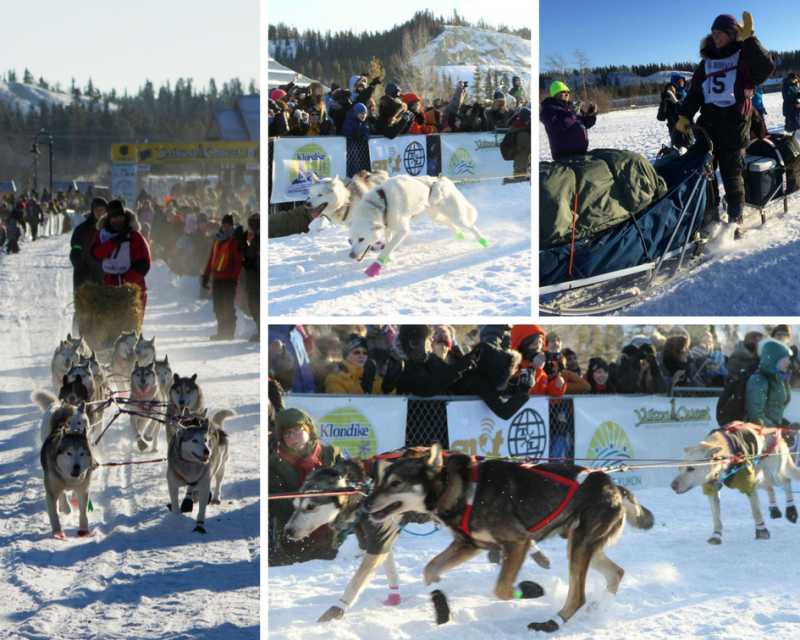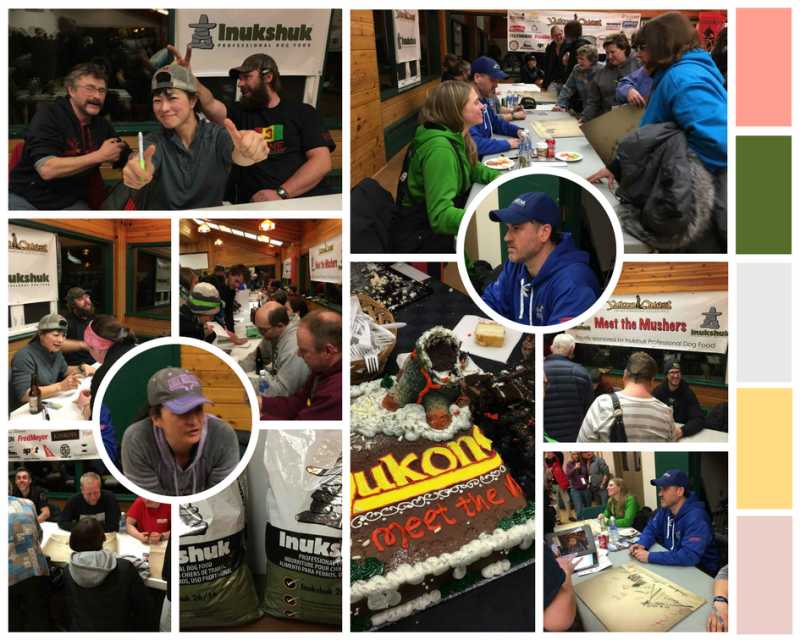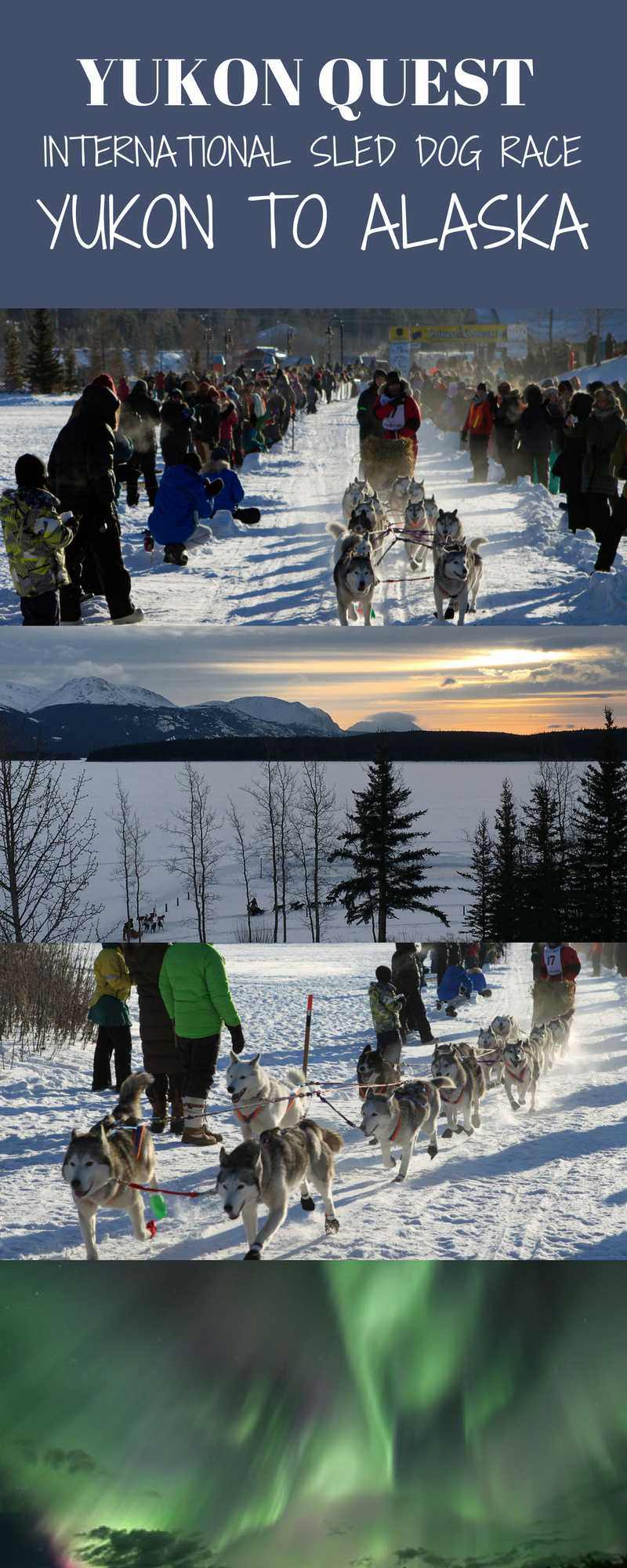Once a year, there’s a big international event called the Yukon Quest. The 1600km (1,000 miles) dog sledding race follows the historic Gold Rush and mail delivery trails between the goldfields of the Klondike and the interior of Alaska.
Soaking up the vibrant atmosphere at the Yukon Quest is one of the amazing things to do in Canada in winter. The start or finish of the race (it depends on which year you’re planning to go) is worthy of your bucket list.
The Yukon Quest
On the day of the race, I head to Shipyards Park in downtown Whitehorse.
It’s 9 am and the temperature is -28C.
The mushers and their dogs are preparing for their big day.
Keen fans mill around the grounds chatting to the mushers, patting the dogs and taking photos.
Turning up early on the day is a good decision and it gives me the chance to chat one-on-one with mushers like Torsten Kohnert from Sweden, who finished in sixth place. And rookie Ed Steelstra, who entered the Yukon Quest to have some fun, experience the culture, see the countryside and absorb the history.
Another musher with a fascinating story is 44-year-old Japanese woman Yuka Honda, who moved to Canada in 1998 to pursue sled dog racing. Check out my Yukon Quest video here:
The day before the Yukon Quest
The day before the Yukon Quest, after checking out a few of these things to do in Yukon, I’m dog sledding through jaw-dropping scenery in the Yukon wilderness.
The milk-white frozen lake and snow-laden trees form an enchanting white winter scene straight out of Narnia.
I tune into the rhythmic patter of feet of the sled dogs and the swishing of runners over the hard-packed snow as my dog sled whooshes through the forest at Ten Mile in the Yukon in Canada.

Dog sledding is an experience that represents the spirit of the Yukon.
If you’ve read Jack London’s The Call of the Wild then you already know that sled dogs are an important part of the Yukon’s history.
These days, there are several ways you can experience dog sledding.
There are one-hour dog sled tours, half-day, full-day and multi-day dog sledding adventures.
You can sit in a sled and watch the scenery whizz past or try mushing your own sled dog team.
I have tried dog mushing a small team myself once before on a previous visit to the Yukon and can tell you standing behind the sled is hard work!
However, on this occasion, I’m quite content to stay warm under a blanket in the sled watching the scenery pass by.
The temperature is around -12C (a heatwave in the Yukon at this time of year).
Bundled up in layers of winter clothing, my body is warm enough.
But whenever I remove my gloves to take photos, my fingers feel stiff and frozen.
Running enthusiastically alongside my dog sled are three five-month-old puppies (M&Ms, Trix and Reese).
Named after chocolate bars, the puppies belong to Yukon Quest veteran musher Ed Hopkins, from Tagish Lake Kennel nearby.
While Hopkins is preparing to race in the Yukon Quest, his naughty puppies are training themselves to be sled dogs.
They run beside the sled for the next two hours with abundant enthusiasm and energy.
The truth about Alaskan Huskies
Running comes almost as naturally as breathing to the sled dogs of northern Canada and Alaska.
Young dogs learn fast and most know instinctively how to pull a sled but teaching them to behave on the line requires a little more work.
This is where older dogs are an asset to mushers. The experienced dogs play a role in guiding the young dogs and keeping the young ones in line.
As a race strategy, sometimes mushers competing in the Yukon Quest will harness up an older dog for part of the race.
The veterans are dropped off at one of the checkpoints after the team has settled down.
Sled dogs in Alaska and the Yukon are known as Alaskan Huskies. But they don’t look anything like the pure-bred blue-eyed Siberian Huskies you’re probably picturing.
Actually, the Alaskan Husky is not recognised as an official breed as the dogs do not have enough common features to classify them as a breed.
During the Gold Rush, sled dogs were bred with whatever dog breed was available.
Some were crossbred with Labradors, German Shepherds, Pointers and Collies.
To me, many of the sled dogs today look more Australian Kelpie than Siberian Husky.

-Sled dogs helped 19th-century adventurers build their lives in the north.
These dogs are endurance athletes that excel in the extreme conditions of the north.
Although dog sledding has evolved from being an essential mode of transport into a tourism activity, most mushers take their vocation seriously.
Where is the Yukon Quest?
The Yukon Quest is a race between Whitehorse in the Yukon and Fairbanks in Alaska.
[google_maps id=”39878″]Whitehorse was a historic hub for shipping and transportation to the Klondike goldfields. Here are some fun things to do in Whitehorse during your visit.
The Yukon Quest is a tough test of endurance between Whitehorse in the Yukon and Fairbanks in Alaska.
What began as a local race in 1984 is now an international event that attracts mushers from around the world.
Quest devotees return time and time again for the challenge of competing in one of the premier races in the sport.
In 2017, 21 teams from Canada, USA, Europe and Japan left the starting line.



The start of the Yukon Quest

Excitement hangs in the air as the Dakhká Khwáan Dancers perform a traditional dance at the starting line of the Yukon Quest.
Whitehorse is home to the Ta’an Kwäch’än and Kwanlin Dun First Nations.
The next attraction is a dog team dressed in beautifully embroidered traditional dog blankets made by the Kwanlin Dün crafting group.
Then the competitors are heralded to the starting line, one team at a time.
Each team has 14 sled dogs hitched up in pairs along the gangline and each dog in the team plays a role, from the leaders to the swing dogs (directly behind the leaders) to the team dogs and the wheelers (strong calm dogs nearest to the sled).
Many of the dogs perform well in several positions and mushers rotate them to avoid repetitive motion injuries, boredom and fatigue.

The dogs bark and jump with excitement while the crowd claps and cheers. The four-legged stars look cute in their booties, which also protect their feet.
It’s obvious the sled dogs are so excited they can hardly wait for the announcer to countdown: three, two, one, go!
They’re off and racing towards the Yukon River.
As soon as the last dog sledding team has left, we drive down to the Takhini River Bridge for another vantage point of the race.
We’re just in time to see teams 20 and 21 sledding across the frozen river on the way to the first checkpoint at Braeburn.
As it happens, musher number 20 (25-year-old Matt Hall) won the race in 10 days, one hour and seven minutes.
Arriving in Fairbanks on the 14 February 2017, Hall crossed the finish line hours ahead of his nearest competitors.
Is the lead dog always the lead dog?

The lead dogs are usually dogs with a lot of confidence (and a few more brains) than the others.
They learn the commands quickly (haw for left and gee for right).
Not surprisingly, there’s a lot of pressure on the lead dogs.
The entire team is depending on them to lead the way and make decisions when the trails are not clear.
For a musher, the lead dog is the most valuable dog and it’s important to rotate the lead dogs so they don’t burn out.
One of the skills of a musher is being able to understand the strengths of each dog and where to place each dog for the best team performance.
Volunteer veterinarians at Yukon Quest
While wandering around the grounds before the race, I bump into several vets who preparing to head to the checkpoints.
The vets are volunteers and a few have worked at the race a number of times in the past.
Mushers are allowed to drop off a dog.
Dogs are usually dropped due to major or minor injuries. But mushers are not allowed to replace any dogs that leave the team
When a sled dog is removed from the team, the veterinary team examines the dog before handing it over to the musher’s support team.
The most common problems the vets have to deal with are injuries to the dogs’ feet.
As snowballs can form between the dogs’ toes and cut their feet, the dogs wear booties.
How the Yukon Quest race is run

There are nine checkpoints where mushers can access food drop bags, straw, water and beds.
Five checkpoints are in the Yukon at Braeburn, Carmacks, Pelly Crossing and Dawson City before crossing over to Alaska.
The teams are not required to stop at all the checkpoints. And some mushers choose to camp out on the trail in their sleds while their dogs curl up alongside them in beds of hay.
It takes months to prepare for the race and the musher’s role is not easy.
There’s a lot of work to do during the race, including strategising, checking gear, massaging their dogs’ feet, feeding their dogs and checking for injuries.
14 dogs require a lot of care and during the race, the only person allowed to do anything for the dogs is the musher.
So if you’re thinking of visiting the Yukon, plan to go during the Yukon Quest.
It’s is a wonderful event that pays homage to the dog teams that helped humans survive and thrive in this remote part of the globe.
What else to do at the Yukon Quest
Meet the Mushers is a free event before the race where fans can meet and talk with the mushers, stock up on Yukon Quest merchandise and collect autographs.
Start & Draw Banquet – Mushers, dog handlers, race officials, dignitaries, volunteers and fans gather for awards, local entertainment and the drawing of the start order.
For other things to experience while in the Yukon read these posts:
For more exciting attractions in Yukon read:
Where to watch the Yukon Quest
The starting and finishing points alternate each year between Whitehorse in Yukon and Fairbanks in Alaska.
If you’re travelling around the Yukon, you might be able to catch the dog sledding teams during the race at Braeburn, which is well-known for cinnamon buns.
Another place is Carmacks, a small town named after one of the first men to discover gold in the Klondike in 1896 or Pelly Crossing, the traditional territory of the Selkirk First Nation. Find out more about the race here.
Where to stay in Whitehorse
While in Whitehorse, it’s best to stay right in town the night before.
Check the latest prices of hotels in Whitehorse here
How to get to Whitehorse
Air North flies to Whitehorse from Vancouver, Kelowna, Calgary, Edmonton, Ottawa (via Yellowknife) and Inuvik (via Dawson City).

Plan Your Trip

Rent A Car – Find the best car rental rates at Discover Cars. They compare car hire companies to provide you with the best deal right now.

Find A Hotel – If you’re curious about this article and are looking for somewhere to stay, take a look at these amazing hotels.





